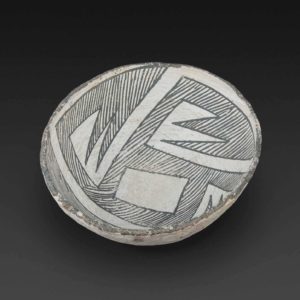A New Perspective
Museum of Indian Arts and Culture Exhibit Highlights Isomeric Design Elements in Ancient Pueblo Pottery

I fell backwards into the profession of graphic design fresh out of college. I graduated with a degree in humanities and, as an alternative to working in the local hospitality industry, I found a job as a secretary in the newsroom of a daily newspaper. Fascinated by the graphic design processes I saw going on all around me, I transferred to the copy and design desk as soon as I could.
Though my education in design followed more of a learning-by-doing approach, I got pretty good, earning national recognition on several occasions. Nonetheless, design for me was always more of an instinctual process than an intellectual one, with little thought to the preciseness of picas or point size or kerning.
This came to mind during my most recent trip to the Museum of Indian Arts and Culture (MIAC) here in Santa Fe, where I stopped in to see the recently installed exhibit: Painted Reflections: Isomeric Design in Ancestral Pueblo Pottery.
Based on a book of the same name by Scott G. Ortman and Joseph Traugott, this exhibit presents examples of Pueblo pottery from throughout the Southwest and is deeply focused on the intricately painted geometric designs on each piece. The exhibit features several complete and reassembled vessels dating from today to as far back as 850 CE.
Ortman and Traugott examine what they call "the hidden source of the pottery's appeal," which they believe can be ascribed to a process they call "isomeric design."
According to the book, "the concept of isomeric design is based on an analogy with isomers in chemistry, which are chemically identical compounds that have mirror-image structures. In Ancestral Pueblo painted pottery, isomeric design is the use of paired forms that can be perceived as reversible."
The designs almost resemble Escher-style optical illusions. The interplay of black-on-white or white-on-black allows viewers to change their perception by focusing instead on the abstract design present on a piece. Previously overlooked white space becomes a star or a series of z-shaped elements. Mirror and reverse images become more apparent. Similar elements can be seen in alternating black-on-white motifs, like checkerboards and individual and interlocked spirals, and in the relationship between hachured and unpainted shapes. The isomeric effect is also seen in repeated forms, like triangles, zigzags, and parallel lines.
While I've been an admirer of Pueblo pottery most of my life, I never really stopped to think how such beautiful designs were created. This exhibition posits that a great deal of thought, and advanced planning, went into the decorating process.
Most fascinating to me were the step-by-step depictions of the painting process. In one instance, the motif started out simply, as the painter divided the surface of a bowl into four sections. A simple geometric design was created, and then reproduced, in each of the four sections of the bowl. The design became increasingly complex as additional elements were added one section at a time until each appeared nearly identical.
While the approach to this topic is a new one, I wonder what the ancient Puebloan peoples might say about such an in-depth examination of their designs. I imagine that, while they recognized the beauty of their work and the work of others, they may have had little notion of the complexities, isomeric or otherwise, attributed to their creations by Ortman and Traugott.
Like me, they learned by watching others, then by doing. If asked to define their work, what would they say? Did each brush stroke have a distinct purpose? Or was design, for them, more of an instinctual process?
This Article is from the Friends of Archeology Newsletter February 2022 by Melissa Martinez
Image Gallup Black-on-White Bowl


Connect